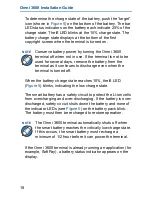
123
Ap
pen
d
ix
Glossary
■
A
Access Point
A link-up point to be connected to the Internet. A
PC can be connected to the Internet via an
access point using a telephone connection.
Administrator Privileges
Access rights that allow access to all functions on
a Windows Vista, Windows XP or Windows 2000
system. A user without administrator privileges
cannot install or uninstall Communication
Configuration Files (Drivers) or the FOMA PC
Configuration Software.
APN
The abbreviation of Access Point Name.
Identifies the network to log into (such as an ISP)
for packet communication. For example, Internet
connection service for DoCoMo, “mopera U”, is
indicated as “mopera.net” for its APN.
■
B
bps
The abbreviation of bit per second, and is a unit to
indicate the data communication speed. It
expresses the number of bits (amount of data)
that can be sent in 1 second.
■
C
cid
The abbreviation of Context Identifier, and is a
registration number when saving an APN of
packet communication to the FOMA terminal. The
FOMA terminal can contain up to 10 APNs.
CSV
The abbreviation of Comma Separated Values,
and is a file format that data is separated with a
comma (,). Can be edited using a text editor.
■
D
Dial-up
Connecting to a network via a telephone
connection.
DNS
The abbreviation of Domain Name System. The
database system that translates an
understandable domain name address, such as
“nttdocomo.co.jp”, into a numerical IP address for
that is used by computers to connect to the
Internet site.
■
H
HSDPA
The abbreviation of High Speed Downlink Packet
Access. It is an improvement on W-CDMA, the
global standard, with a higher packet
communication speed. In the FOMA High-Speed
area, high speed packet communication with a
receiving speed of up to 3.6Mbps is possible.
■
I
ID
A number to manage user information. Your ID is
issued when you register as a new user.
Install
Copying external data contained in a CD, etc.
onto a PC so that the data can be utilized.
IP
The abbreviation of Internet Protocol,
communication rules used over the Internet as
standards.
IP address
A numerical value that identifies a device
connected to the Internet. Normally, it is
expressed as four 4-digit numbers (0 - 255)
separated with a period as “XXX.XXX.XXX.XXX”,
and is assigned to every device connected to the
Internet.
ISDN
The abbreviation of Integrated Services Digital
Network, and is a comprehensive digital
communication network. Enables faster
communication speed than an analog telephone
line.
ISP (Internet Service Provider)
An operator that provides a connection to the
Internet. Generally, in order to use the Internet,
you need to subscribe to an ISP.
■
M
Modem
A device that allows a PC to communicate via a
telephone connection.
■
P
Port
An auxiliary address added under an IP address
in order to connect multiple parties concurrently
over the Internet. A port is identified with a
numeric value from 0 to 65535 which is called the
“Port Number”.
Properties
“Attributes” or “configurations” of Windows files or
icons. Right-click an icon to see or change its
properties.
Protocol
Communication rules used by devices to
exchange data.
■
Q
QoS
The abbreviation of Quality of Service, and is a
measure of the quality of the service of a network.
You can specify conditions of data
communication speed in the FOMA terminal QoS
configurations (actual communication speed
varies depending on the communication
conditions).
→
P115
■
V
vCard
A special format for exchanging business card
data. Many e-mail programs support this format.
Glos
sary
Continued on the next page









































